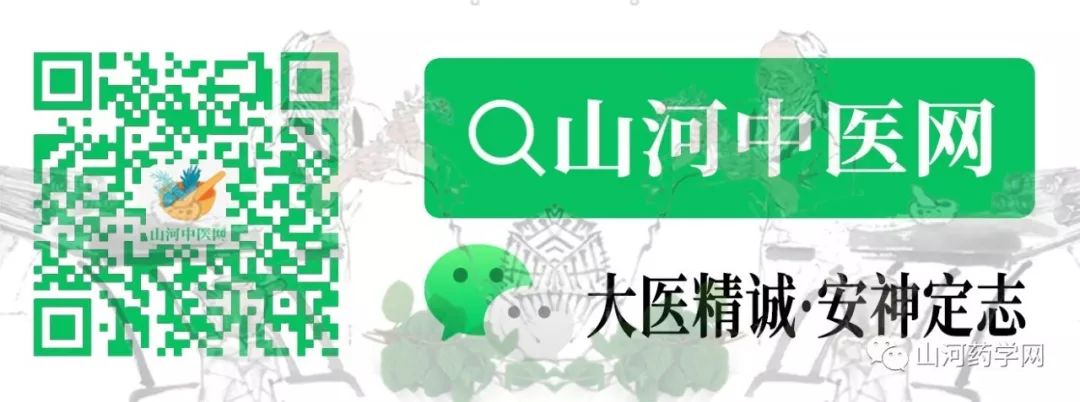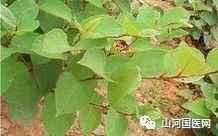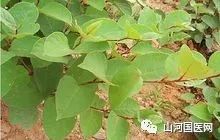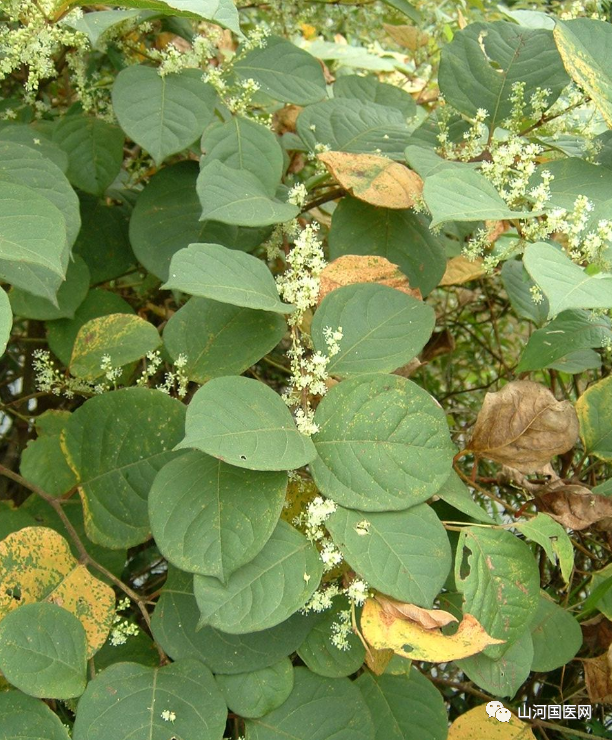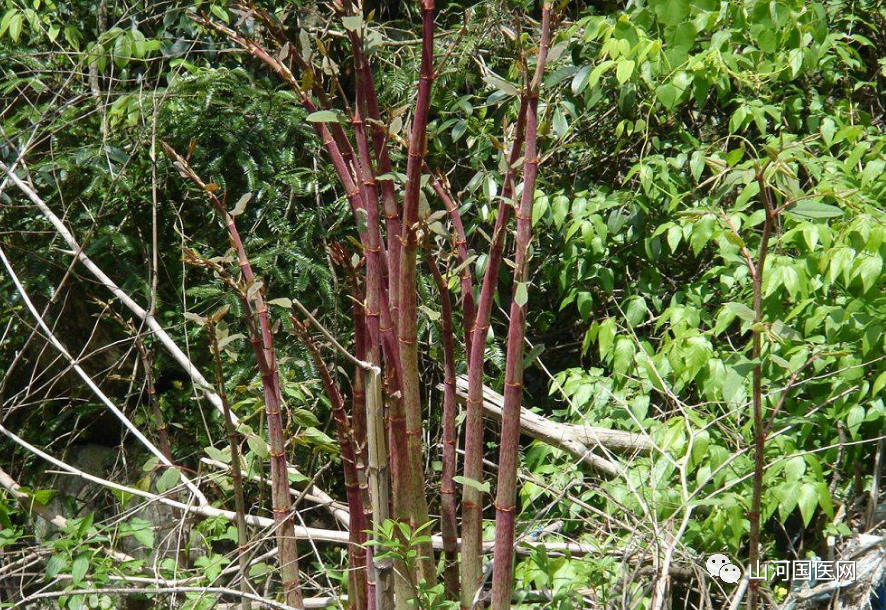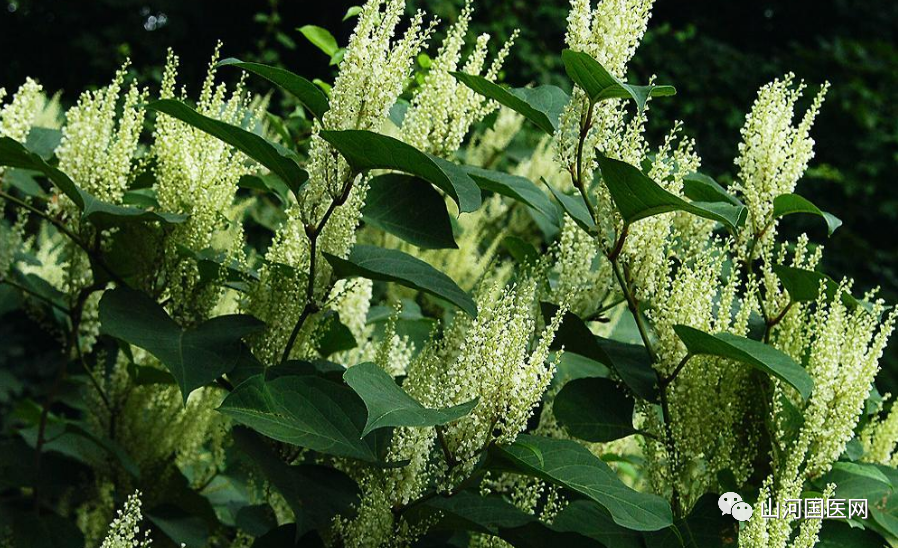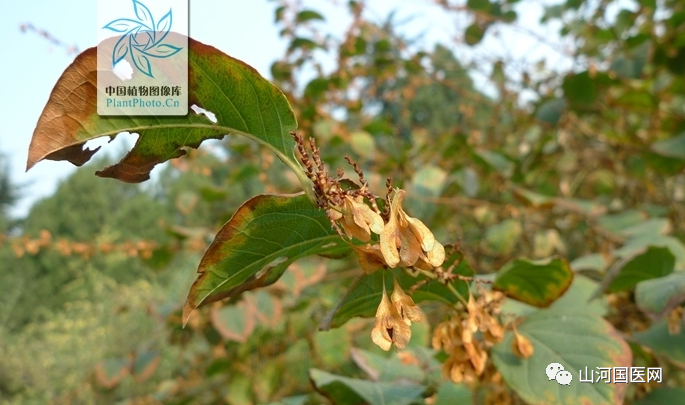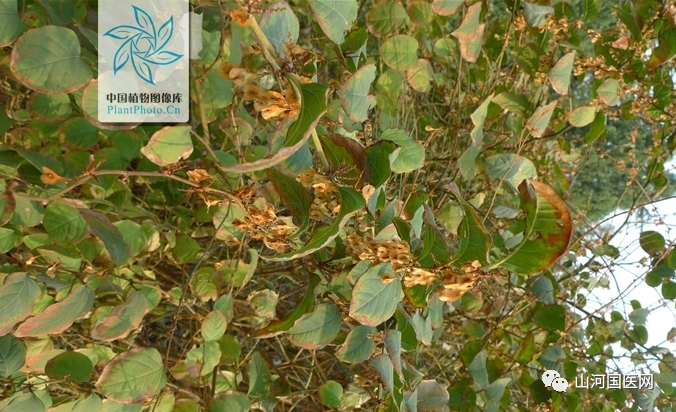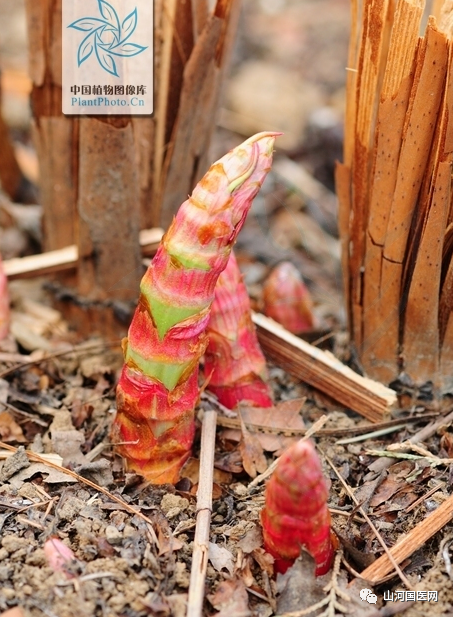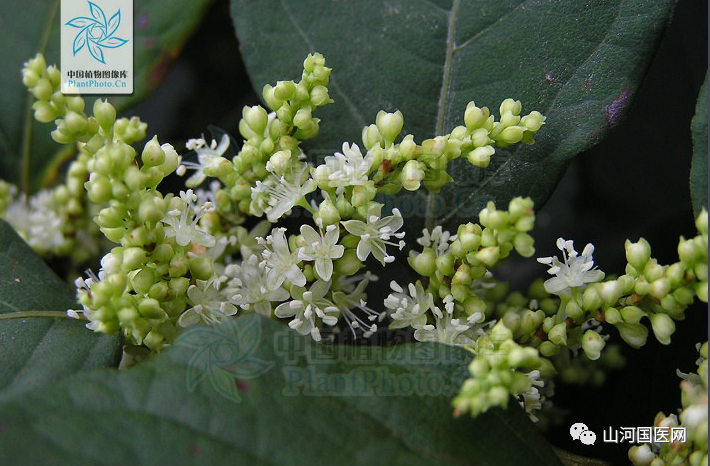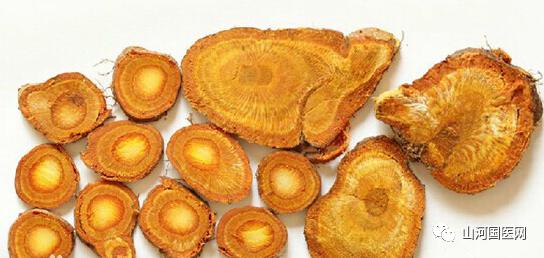| Hu Zhang Hǔ Zhànɡ | |
|---|---|
|
|
|
| Aliases | Huaban Zhu, Suan Tong Gan, Suan Tang Geng, Chuan Jin Long, Banzhuang, Banzhang Gen, Daye Shezongguan, Huang Diyi, Tuo, Dachongzhang, Ku Zhang, Suan Zhang, Banzhang, Suan Tong Sun, Banzhuang Gen, Niao Bu Ta, Suan Gan, Ban Gen, Suan Liu Gen, Tudi Qing, Suan Tong, Xiong Huang Lian, Shezongguan Da Huoxue, Suan Tang Gan, Hou Zhu, Ku Zhang Gen, Du Niu Xi, Huang Yao Zi, Tudi Yu, Ci Huang Lian, Shezongguan Da Huoxue, Suan Tang Gan, Hou Zhu Gen, Jin Suo Wang, Jiu Long Gen, Shan Qie Zi, Ban Cao, Ban Dao Zeng, Jiu Gu Niu, Da Jie Gu, Lao Jun Dan |
| Functions | Qing Feng Li Shi (Expel Wind and Eliminate Dampness), San Yu Ding Tong (Disperse Stasis and Alleviate Pain), Zhi Ke Hua Tan (Stop Cough and Transform Phlegm). Used for joint pain, damp-heat jaundice, amenorrhea, abdominal masses, burns, trauma, carbuncles, and cough with excessive phlegm. |
| First Recorded In | Shennong Bencao Jing |
| Toxicity | Non-toxic |
| Meridians Entered | Gallbladder Meridian, Liver Meridian |
| Nature | Neutral |
| Taste | Bitter |
Introduction
【Aliases】 Huaban Zhu, Suan Tong Gan, Suan Tong Sun, Suan Tang Geng, Chuan Jin Long, Banzhuang, Banzhang Gen, Daye Shezongguan, Huang Diyi【Source】 This product is the dried rhizome and root of the plant Hu Zhang (Polygonum cuspidatum) from the family Polygonaceae.【Harvesting and Storage】 Harvest in spring and autumn, remove the fibrous roots, wash clean, cut into short sections or thick slices while fresh, and dry. Store in a dry place to prevent mold and pests.【Characteristics】 This product is mostly cylindrical short sections or irregular thick slices, 1-7 cm long, 0.5-2.5 cm in diameter. The outer skin is brownish-yellow, with longitudinal wrinkles and fibrous root marks. The cut surface has a thinner skin layer and a broad wood part, which is brownish-yellow with radial rays. The skin and wood parts are easily separable. The rhizome has partitions or is hollow. It is hard in texture, with a faint odor and a slightly bitter, astringent taste.【Properties and Meridians】 Slightly bitter, slightly cold. Enters the Liver, Gallbladder, and Lung meridians.【Functions and Indications】 Clears heat and detoxifies, promotes bile secretion and reduces jaundice, expels wind and eliminates dampness, disperses stasis and alleviates pain, stops cough and transforms phlegm. Used for joint pain, damp-heat jaundice, amenorrhea, abdominal masses, cough with excessive phlegm, burns, trauma, carbuncles, and sores.【Dosage】 Decoction, 9-15g. For external use, apply an appropriate amount as a decoction or ointment.【Precautions】 Use with caution in pregnant women.Hu Zhang is not only ornamental but also edible; the tender stems are used as vegetables, and the roots are made into cold drinks, placed in cool water for cooling (especially chilled in the refrigerator), known as “cold drink” to relieve heat and replace tea. Its juice can dye rice noodles, giving it a unique flavor. Due to its sour taste, it is also called “Suan Tang Gan”.Hu Zhang contains polydatin, organic acids, glycosides, polysaccharides, etc. It has heat-clearing, detoxifying, cooling, and digestive benefits.【Morphological Characteristics】 A perennial herbaceous plant resembling a shrub, hairless, 1-1.5 meters tall. The rhizome runs horizontally underground, woody, with a yellow-brown outer skin. The stem is erect, clumping, hollow, with scattered red or purple spots on the surface. The leaves are broad ovate or ovate-elliptic, 6-12 cm long, 5-9 cm wide, with a sharp tip and a rounded or broadly wedge-shaped base; the stipules are brown and fall off early. The flowers are unisexual, with male and female plants, forming axillary racemes; the flower stalks are long and slender, with joints in the middle and wings at the top; the calyx is deeply divided into 5 lobes, with 2 whorls, the outer whorl has 3 lobes that enlarge when fruiting, and wings grow on the back; there are 8 stamens; the style is 3-lobed, with a crown-shaped stigma. The achene is oval, with 3 angles, black-brown, and shiny. The flowering period is from June to July, and the fruiting period is from September to October.Distribution: Found throughout the province, distributed in Shandong, Henan, Shaanxi, Hubei, Jiangxi, Fujian, Taiwan, Yunnan, Sichuan, and Guizhou.Uses: The rhizome is medicinal, with effects of promoting blood circulation, dispersing phlegm, expelling wind, detoxifying, anti-inflammatory, relieving pain, eliminating damp-heat jaundice, treating chronic bronchitis, and lowering blood lipids; the whole plant can be used as animal medicine to treat bloat in cattle and wasps’ stomach diseases; it can also be made into pesticides, effective against pests like rice weevils and aphids; both the rhizome and leaves contain tannins, which can be used to produce tannin. The rhizome contains flavonoids, emodin, and polydatin. Propagation is done using rhizomes or seeds.Names: Ku Zhang, Da Chong Zhang, Banzhang, Suan Zhang.Taste: (Root) Slightly warm.
Indications
1. Dysuria. Use Hu Zhang powder, 6g, taken with rice soup.2. Amenorrhea. Use 300g of Hu Zhang, 60g of Lingxiao flower, and 60g of myrrh, ground into powder. Take 3g with hot wine. Another formula: 600g of Hu Zhang, remove the head, dry, grind finely, soak in 5 dou of water overnight, decoct to obtain 2 dou. Add 2 dou of juice from Tudi Guo and Niuxi, boil together until thick, take 1 cup with wine. Take twice during the day and once at night, and menstruation will resume.3. Abdominal masses that are hard as stone and painful. Use 1 kg of Hu Zhang root, wash, and grind into powder, mix with 5 liters of rice, and stir well, then soak in 5 dou of wine. Take 1.5 liters, avoiding fresh fish and salt.4. Strange disease (a sound under the skin, itching all over, scratching causes bleeding but does not stop itching). Use Hu Zhang, ginseng, Qingyan, and Xixin, each 30g, add water and decoct as a drink.5. Diabetes. Use Hu Zhang, Hai Fu Shi (burned), cuttlefish bone, and cinnabar, equal parts ground into powder, take 6g with wheat and winter soup when thirsty. Take three times a day, avoiding alcohol, fish, flour, cold food, and sexual activity.Additional formula: The function of Hu Zhang is to clear heat and detoxify, promote blood circulation, and regulate menstruation. Currently, Hu Zhang, Mu Xiang, Zhi Ke, and Huang Qin are used clinically to treat liver conditions.
Discussion by Various Schools
1. Bencao Shu: The main treatment of Hu Zhang is similar to that of Tianmingjing, and its treatment of wind is similar to that of Wang Buliuxing. Many ancient scholars believed it to be the best for clearing summer heat toxins, thus removing the heat generated from blood, hence treating the blood organs of the hand and foot. It is used to treat spasms, similar to other heat-clearing herbs, but its use in other conditions is rare. Why? It is used to treat dysuria, as Danxi treated elderly patients with blood injuries, considering it a key medicine, and it is used in tonics. It is said that it can be harmful to the weak when used with tonics.2. Shennong Bencao Jing emphasizes its ability to promote menstruation and break blood stasis.3. Tao Hongjing: It is used for violent abdominal masses, taken with wine.4. Yao Xing Lun: Treats great heat and irritability, stops thirst, and promotes urination, suppressing all heat toxins.5. Bencao Shiyi: Treats wind in the joints and blood stasis. Brew the juice and take it as wine.6. Rihua Zibencao: Treats postpartum blood not flowing, abdominal distension. Discharges pus, treats sores, carbuncles, and toxic conditions, women’s blood dizziness, and bruises.7. Dian Nan Bencao: Attacks various swellings and toxins, relieves throat pain, promotes urination, and travels through meridians. Treats five types of dysuria, hemorrhoids, sores, and women’s red and white discharge.8. Yilin Zuan Yao: Strengthens the kidneys, boosts yang, benefits essence, strengthens muscles and bones, increases strength. Can be applied to areas of injury to promote healing.9. Lingnan Cai Yao Lu: Treats snake bites, carbuncles, and relieves pain from injuries.10. Guizhou Minjian Fang Yao Ji: Astringes and stops bleeding, treats hemorrhoids, expels wind and dampness, disperses cold, and disperses blood stasis, for external use in treating burns.11. Chinese Medicine Experimental Research: Treats real fire toothache, wet sores, and rotten legs, and damp rotten toes.12. Yao Xing Lun: Hu Zhang, boiled with licorice in summer, is amber-colored, pleasant to look at, tastes sweet, and is placed in a well to cool and clarify like ice, served in white porcelain or silver vessels, resembling tea, and is called “cold drink” by people, also esteemed in tea.13. Benshi Fang: The root of Hu Zhang is commonly called Du Niu Xi, often cleaned and crushed, using 6g with 5 cups of water, decocting to 1 cup, removing residue. Add a little musk and frankincense, ground and mixed, to treat various types of dysuria. In Yinxian, a military officer named Geng Mengde had a wife suffering from sand and stone dysuria for thirteen years. Each time she urinated, she felt unbearable pain, and sand and stones were heard in the urinal. After trying many treatments without effect, she found this formula and was cured overnight, as witnessed.
Plant Morphology
A perennial herbaceous plant resembling a shrub, reaching over 1 meter in height. The rhizome runs horizontally underground, woody, yellow-brown, with distinct nodes. The stem is erect, clumping, hairless, hollow, with scattered purple-red spots. The leaves are alternate; the petioles are short; the stipules are membranous, brown, and fall off early; the leaf blades are broad ovate or ovate-elliptic, 6-12 cm long, 5-9 cm wide, with a sharp tip and a rounded or wedge-shaped base, entire, and hairless. The flowers are unisexual, with male and female plants, forming axillary racemes; the flower stalks are long and slender, with joints in the middle and wings at the top; the calyx is deeply divided into 5 lobes, with 2 whorls, the outer whorl has 3 lobes that enlarge when fruiting, and wings grow on the back; there are 8 stamens; the style is 3-lobed, with a crown-shaped stigma. The achene is oval, with 3 angles, black-brown, and shiny. The flowering period is from June to August, and the fruiting period is from September to October.
Adverse Reactions and Treatment
Hu Zhang can cause leukopenia. The tannins contained in Hu Zhang can permanently bind with vitamin B1, so when taking large amounts of Hu Zhang for a long time, vitamin B1 should be supplemented as needed.
Identification of Medicinal Materials
Physical IdentificationThe rhizome is cylindrical, branched, varying in length, some can reach 30 cm, with a diameter of 0.5-2.5 cm, slightly swollen at the nodes. The surface is brownish-yellow to gray-brown, with distinct longitudinal wrinkles, fibrous root marks, and bud marks at the tips and nodes. The internodes are 2-3 cm long. It is hard in texture, not easily broken, with a brownish-yellow fracture surface, fibrous, with the skin and wood parts easily separable, the skin part is thinner, and the wood part occupies a larger portion, showing radial rays, with a central pith or hollow, and the longitudinal section has transverse partitions, with a faint odor and a slightly bitter, astringent taste. The best quality is thick and solid, with a yellow fracture surface.Microscopic IdentificationCross-section of the rhizome: The cork layer consists of 5-10 rows of cork cells, reddish-brown. The cortex is relatively narrow, scattered with fiber bundles, and sometimes branched stone cells can be seen extending tangentially; the parenchyma cells contain clusters of calcium oxalate crystals and starch grains. The phloem also has fiber bundles and clusters of calcium oxalate scattered. The cambium forms a ring. In the xylem, the wood fibers are well-developed, with fewer vessels, often single or in small bundles scattered among the wood fibers and wood parenchyma cells, with wood rays consisting of 2-7 rows of cells. The pith contains parenchyma cells with clusters of calcium oxalate crystals; sometimes round stone cells can be seen.Powder CharacteristicsBrownish-yellow or brown. ① Calcium oxalate clusters are relatively large, with a diameter of 21-110μm, and the angles are blunt. ② The phloem fibers are bundled, elongated, relatively straight, lignified, with fine punctate or cross-shaped pores, and the lumen contains starch grains, some fibers have transverse partitions. ③ Stone cells are often connected in groups of 2-3, spindle-shaped, rectangular, or elongated into fibrous shapes. The pores are unevenly distributed, and the lumen contains starch grains, some stone cells have transverse partitions. ④ The cortex fibers are spindle-shaped or long spindle-shaped, with irregular edges, 180-335μm long, with slightly thickened lignified walls, sparse pores, some with transverse partitions. ⑤ The wood ray cell walls are relatively thickened and lignified, with dense pores. ⑥ Numerous starch grains, single grains are round, with a diameter of 3-13μm, with punctate hilum, and compound grains mostly consist of 2-4 component grains.Chemical Identification(1) Take 5g of the coarse powder, add 25ml of ethanol, soak for 2 hours, and filter. Evaporate the filtrate to dryness, add about 2ml of water to the residue, stir well, take the supernatant, add 10ml of chloroform, shake to extract, and collect the chloroform layer, then evaporate to dryness. Add 2 drops of sodium hydroxide solution to the residue, and a cherry-red color appears.(2) Take the water layer after chloroform extraction, add 10ml of ethyl acetate, shake to extract, collect the ethyl acetate layer, evaporate to dryness, add about 5ml of water to the residue, and extract with 5ml of ether. Collect the ether layer, evaporate to dryness, dissolve the residue in 1ml of ethanol, and spot on filter paper, then observe under ultraviolet light, showing bright blue fluorescence (to check for flavonoids). (3) Take the water layer after chloroform extraction, add 2 drops of ferric chloride solution, and a dirty green color appears (to check for condensed tannins).(4) Thin-layer chromatography: Take 5g of the powdered sample (40 mesh), extract with methanol, concentrate, and prepare as a test solution. Take reference solutions of emodin, methyl emodin, and rhein, and spot both solutions on a silica gel G thin-layer plate, using benzene-anhydrous ethanol (8:2) as the developing agent, with a development distance of 13cm, and color with ammonia vapor. In the test sample chromatogram, corresponding spots appear with the same cherry-red color as the reference solution.
Medicinal Application Identification
1. Hu Zhang and Ji Xue Teng are both blood-activating and stasis-dispelling medicines, but their effects differ. Ji Xue Teng is sweet and warm, with blood-tonifying effects, most suitable for blood stasis with blood deficiency; Hu Zhang is bitter and cold, able to cool blood and dispel stasis, suitable for blood heat with stasis and heat disease with unconsciousness.2. Hu Zhang, Jiang Huang, and E Zhu are all blood-activating and stasis-dispelling products used to treat blood coagulation and qi stagnation. However, Hu Zhang’s properties are relatively cold, able to cool blood and detoxify, suitable for treating sores and swellings.My Experience with Hu ZhangHu Zhang was first mentioned in the Bencao Gangmu, but for some reason, it gradually fell out of use. Ye Tianshi’s Clinical Guidelines states: “Between the essence and the orifice, there must be a tangible obstruction… First, discuss the method of clearing corruption, and consider ancient formulas to clear dysuria and stasis, using Hu Zhang decoction. Nowadays, few recognize this medicine, often substituting it with Du Niu Xi.” This indicates that by Ye Tianshi’s time, it was already “not recognized.” Until the 1950s, the pharmacologist Ye Jiquan’s famous work Modern Practical Chinese Medicine was published, which did not include Hu Zhang, and it was only later included in his Bencao Tui Chen compilation.Hu Zhang is found in many places in northern Sichuan and southern Gansu, especially in moist areas along rivers. It belongs to the Polygonaceae family, grows in clumps, with stems 1-2 meters tall, erect like a staff, green, hollow, with spots resembling blood. In Sichuan, it is commonly called “Huaban Zhu” or “Xiong Huang Lian”; the former refers to its plant morphology resembling bamboo with flower spots, and the latter may be due to its heat-clearing and fire-draining effects. In Guangdong, it is named “Daye Shezongguan,” indicating its use for snake bites.My experience with Hu Zhang includes the following aspects:1. For pneumonia, Hu Zhang is slightly bitter and neutral (according to the Chinese Herbal Medicine Dictionary), or considered bitter and cold (according to Ye Xianchun’s Chinese Medicine), or sweet, bitter, and spicy (according to Yilin Zuan Yao). It is an ideal medicine for various types of pneumonia: its slight spiciness can expel pathogens outward; its bitter cold can clear heat and eliminate dampness, but it is not overly bitter, thus not harming the stomach; it enters both the qi and blood levels, having the ability to clear qi, cool blood, and invigorate blood; it can promote urination and open the bowels, having a dispersing nature that guides damp-heat phlegm-fire downward. Thus, it can address both external pathogens and phlegm, heat, and stasis, making it a versatile medicine for pneumonia pathology. In the past 30 years, pneumonia formulas in Chongqing, Shanghai, and Beijing have all used Hu Zhang, with slight variations in combinations. The Chongqing formula uses Hu Zhang with Baijie Cao, Yuxing Cao, and Weilingxian; the Shanghai formula uses Hu Zhang with Duckweed, Yuxing Cao, Jin Qiao Mai Gen, and Baihua She She Cao, while the Beijing formula combines Hu Zhang with Dandelion, Ban Zhi Lian, and Baijie Cao. Recently, an elder from Shanghai sent me a copy of his “Pneumonia Decoction,” which includes Hu Zhang and Yuxing Cao, with the idea of using Ban Zhi Lian, Duckweed, Jin Qiao Mai (i.e., Jin Suo), and Yuxing Cao to clear heat and detoxify, while Hu Zhang promotes bowel movement and drains heat, invigorating blood and transforming phlegm; Bai Bu stops cough and lowers qi. The elder also mentioned: if there is initial aversion to cold without sweating, add Qiang Huo to induce sweating and reduce fever; if there is high fever with constipation, add raw Da Huang to promote bowel movement and drain heat; if there is severe cough and wheezing, add Ting Li Zi to drain lung heat and phlegm water. The elder Deng Tietao also heavily used Hu Zhang in treating SARS, possibly to invigorate blood and promote water metabolism in the lung interstitium, preventing pulmonary fibrosis. In previous literature, there are reports of using 500g of dried Hu Zhang with 5000ml of water, decocting to 1000ml, taken three times a day, with body temperature returning to normal within 24 hours, and chest X-rays showing absorption of lung inflammation, with an average treatment duration of 9 days. Modern pharmacological studies show that Hu Zhang has inhibitory effects on various bacteria, viruses, and leptospirosis, and also has cough-relieving, antiasthmatic, phlegm-transforming, laxative, and diuretic effects. Based on literature and personal experience, I previously published in the Chinese Medicine News that Hu Zhang is an ideal medicine for mid-stage pneumonia, for reference in clinical practice.2. For gout, Western medicine defines gout as a metabolic disorder primarily characterized by pain in a single joint. It often occurs in the lower limbs, particularly below the knee, with pain like a knife, often occurring at night, with local redness, swelling, and heat, thick and greasy tongue coating, and a slippery and rapid pulse, indicating damp-heat stasis. Although gout falls within the scope of TCM’s bi syndrome, treatment with general wind-cold or damp-heat methods often yields poor results. My teacher, Zhu Liangchun, based on his consistent approach of combining disease differentiation and syndrome differentiation, named Western medicine’s “gout” as “Zhuo Yu Bi,” using methods to drain and transform turbid stasis, heavily employing Tu Fu Ling (commonly used at 60g), Hu Zhang, Liu Cao, Bi Xie, Yi Ren, and Wei Ling Xian (commonly used at 30g each), combined with Ze Lan, Ze Xie, Qin Jiao, Tao Ren, Chi Shao, Di Long, Cang Zhu, Huang Bai, and Niu Xi, achieving significant effects. After alleviating pain, tonifying kidney herbs such as Shu Di, Bu Guo Zhi, and Guo Sui Bu can be added for completion. In the spring of 1997, I accompanied Zhu Lao to Wuxi for consultations, where a significant portion of the patients were gout sufferers, many of whom were repeat patients, reflecting excellent results. In recent years, I have also used Zhu Lao’s method to treat gout in Beijing with many successful cases. Hu Zhang can adjust the gastrointestinal tract, expelling metabolic waste retained in the joints, and has heat-clearing, blood-invigorating, and pain-relieving effects. Bencao Shiyi states it “mainly treats wind in the joints and blood stasis,” while Dian Nan Bencao states it “attacks various swellings and toxins… promotes urination and travels through meridians,” thus it should be regarded as an indispensable product for gouty arthritis.3. For chronic prostatitis, chronic prostatitis is one of the common diseases in middle-aged and elderly men, often accompanied by prostatic hyperplasia (enlargement), with primary symptoms of urinary difficulties: waiting to urinate, thin urine stream, frequent urination, and nocturia, thus often classified under TCM’s “dysuria” category. However, using general diuretic and urination-promoting medicines often proves ineffective, and antibiotics or other anti-urinary tract infection medications also show limited efficacy, or only temporary effectiveness with frequent recurrences, causing frustration for both patients and doctors. My classmate Zhou Anfang has studied this disease for many years, proposing that the basic pathogenesis is “kidney deficiency and liver excess,” which captures the essence. For dysuria related to kidney deficiency, ancient texts have long recorded that “dysuria occurs due to kidney deficiency and bladder heat”. Liver excess encompasses damp-heat, qi stagnation, and blood stasis. Based on this, I often select He Shou Wu, Bu Guo Zhi, Rou Cong Rong, Tu Si Zi, Sheng Shu Di, Yin Yang Huo, Xu Duan, and Niu Xi; for damp-heat, I prefer Hu Zhang (dosage 24-30g), followed by Hai Jin Sha, Bai Jiao Cao, Baihua She She Cao, Huang Bai, Yi Ren, Bi Xie, and Shi Wei; for qi stagnation (with a feeling of distension in the perineum), I use Zhi Ke, Chai Hu, Wu Yao, and Mu Xiang; for blood stasis (with prostatic hyperplasia causing local enlargement or hardness), I use Tao Ren, Shan Jia Zhu, Hu Po, Dan Shen, Zao Jiao Ci, Chi Shao, and Yi Mu Cao; for blood in urine, I add fresh Bai Mao Gen, fresh Che Qian Cao, Xiao Ji, Pu Huang, Hua Shi, Da Huang, and Liu Cao. Hu Zhang can clear heat and eliminate dampness, invigorate blood and dispel stasis, making it indispensable. Hu Zhang is also widely used for various dysurias. The Song Dynasty scholar Xu Shuwei recorded in Benshi Fang that using Hu Zhang decoction, mixed with a little musk and frankincense, is very effective for treating sand and stone dysuria. A woman suffering from this condition experienced unbearable pain during urination, with sand and stones heard in the urinal, and after many ineffective treatments, she found this formula and was cured overnight, as witnessed. The ancient formula mentioned by Ye Tianshi, “Hu Zhang San,” clears dysuria and stasis, possibly using the Jiyuan Fang (using 6g of Hu Zhang as powder taken with rice drink), or it could be Xu’s formula. Aside from these two formulas, there are few mentions of Hu Zhang in ancient texts before Ye’s time.4. For metabolic disorders, Hu Zhang has the function of adjusting the gastrointestinal tract and promoting urination, so I often use it to treat high blood sugar, high uric acid, high blood lipids, high cholesterol, simple obesity, habitual constipation, and hypertension, showing good efficacy in adjusting metabolic disorders. For example, an old friend, Lei Zhaoxiang, 63 years old, weighing 158 pounds (height 1.72m), with a large abdomen, severe fatty liver, and blood lipids and cholesterol above normal (exact numbers unknown), living in Guangdong, often angry. I sent him a formula to dry dampness and promote the spleen, combined with liver soothing: Hu Zhang 30g, Ze Xie 30g, Gan He Ye 30g, Cang Zhu and Bai Zhu each 15g, Fa Ban Xia 15g, Hou Po 10g, and Fu Ling 15g, Chen Pi 10g, Dong Gua Pi 30g, Chai Hu 10g, Jiang Huang 10g, and Yu Jin 10g, plus Ming Fan, a grain-sized piece daily. After 26 doses, his bowel movements initially increased to 3 times a day, gradually reducing to 2 and then 1 time, with no discomfort. After requesting another formula, I stopped Ming Fan and added Chi Shao, Chuan Lian Zi, Yi Ren, Dan Pi, Bo He, Qing Pi, and Che Qian Cao. After 15 doses, he felt much better, with his weight dropping from 158 pounds to 128 pounds, and tests showed normal cholesterol and blood lipids, with fatty liver disappearing, so I stopped the medication. In 2002, after returning to Sichuan, I met him several times, and he still insists on exercising, has quit smoking, drinks less, and eats moderately, feeling good physically and mentally, though his weight has slightly increased.Recently, I treated Xu (outpatient number 215), a 51-year-old woman with a family history of diabetes, who recently had a fasting blood sugar of 7mmol/L, postprandial 9mmol/L, triglycerides 3.4 mmol/L, uric acid above 500 mmol/L, and slightly elevated blood pressure. Her pulse was slippery and rapid, tongue pale with greasy coating, so I planned to strengthen the spleen and promote fat metabolism, using He Shou Wu, Ze Xie, Gan He Ye, Dong Gua Pi, Cang Zhu, Hou Po, Shan Zha, Dan Shen, Sang Ji Sheng, Chen Pi, Fa Ban Xia, Cao Jue Ming, Yi Ren, and Ji Nei Jin, after 14 doses, I added Hu Zhang and Jiao San Xian. After one month, her fasting blood sugar dropped to 5.6, postprandial to 7.8, blood lipids to 1.6, uric acid normalized, and blood pressure also returned to normal.5. For jaundice, Hu Zhang has the effects of clearing heat, invigorating blood, and promoting bile secretion to reduce jaundice, commonly used for gallbladder inflammation, gallstones, and acute infectious hepatitis with jaundice due to damp-heat stasis, making it very suitable. In 1975, while working in the Netherlands, the wife of overseas leader Dong Shimin underwent surgery for gallbladder stones at Leiden University Medical Center. On the third day post-surgery, she had a high fever, nausea, vomiting, and abdominal distension like a drum, with a yellow complexion and yellow urine like strong tea. I was urgently called to visit, and the Dutch doctors admitted that the surgery was unsuccessful, leading to bile leakage into the abdominal cavity, causing biliary peritonitis. In addition to antibiotics, they also punctured the lower abdomen to wash with saline, and the material expelled was dark green and moss-like. Upon examining her pulse, it was slippery and rapid with strength, the tongue was red with a thick yellow greasy coating. The diagnosis was internal heat with solid evidence, so I used a modified Da Chai Hu Decoction: Chai Hu 15g, Huang Qin 15g, Gan Ban Xia 12g, Zhi Shi 15g, Hou Po 10g, Yin Chen 30g, Hu Zhang 30g, Zhi Zi 15g, Chi and Bai Shao each 15g, Huo Xiang 15g, and Lian Hua 15g. On the third day after taking the medicine, the high fever subsided, abdominal distension significantly improved, and bowel movements increased to 3-4 times a day, with jaundice reducing significantly, and after adjusting the formula, she recovered in less than half a month. After discharge, her waist could not straighten, and half of her hair had fallen out. This was the most severe case I encountered while working abroad, and many years later, it remains vivid in my memory. Afterward, the Dutch doctors were quite surprised by the rapid alleviation of her condition, stating that it was the first time using Chinese medicine for acute abdominal conditions at Leiden University.Hu Zhang has many cases used for gallstones; here is one example: Li, a 55-year-old woman from the Aerospace Ministry, came for consultation on June 13, 1997, suffering from gallbladder stones, with several stones, the largest being 0.8 cm, experiencing discomfort and pain in the upper right abdomen and right shoulder, with a deep and wiry pulse and slightly greasy tongue coating, and dry stools. I used Jin Qian Cao combined with Hu Zhang, Mu Xiang, Chai Hu, Shan Zha, Dan Shen, Yu Jin, Ji Nei Jin, Cao Jue Ming, Zhi Ke, Wei Ling Xian, Chi and Bai Shao, and Xiang Fu, taking intermittently for 3 months. By the end of the year, the largest stone had disappeared, but there were still small sand-like stones, with slight pain persisting. After continuing for more than 10 doses, the pain disappeared, and upon re-examination, the small stones were no longer present.6. For acne, acne and pimples are often caused by damp-heat in the spleen and stomach combined with phlegm and blood stasis, commonly occurring in adolescents of both genders, primarily on the face, but also seen on the chest, back, and buttocks. The treatment focuses on clearing heat and detoxifying, invigorating blood and dispelling stasis, and transforming phlegm and dissipating masses. I often use Hu Zhang and Baihua She She Cao as the main medicines, combined with Yinhua, Wild Chrysanthemum, Danshen, Huangqin, Lianqiao, Purple Flower Diding, Baizhi, Chi Shao, Muli, Tianhuafen, Jiangcan, and Sheng Gancao. A course of treatment consists of 14 doses, which can be used continuously for 1-3 courses. For mild cases, only use Hu Zhang 20g and Baihua She She Cao 30g. After soaking in hot water, it can be used as tea, usually showing effects within 1-2 courses. However, cystic, indurated, or those forming sinuses or scars require longer treatment, and external treatment methods should also be combined.Disclaimer:The content on this site is added and organized by users for learning and reference purposes. The information on the site may not be accurate, comprehensive, or up-to-date, and the content should not be the final basis for diagnosing or treating diseases.Shanhe Traditional Chinese Medicine Network reminds users that if there are any physical discomforts, please seek medical attention promptly. Thank you for your support and love; we will strive to do better~!!!
